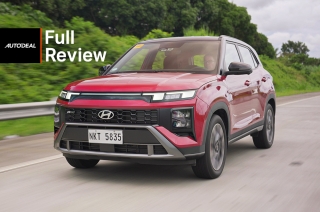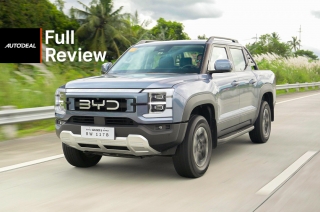
There are certain forbidden topics when in a debate with friends, especially during drinking sessions – religion, politics, and whether the Nissan Juke looks good or not. While this attention-seeking vehicle from Nissan has its own share of critics, car buyers in AutoDeal seem to like how it looks. In fact, it's included in our Top 20 Most Inquired For Car Models for 2016.
However, how does the Juke perform on the road? How is it as a daily vehicle? Or as a barkada getaway car? Good thing, Nissan Philippines handed us over the keys to a 1.6L Upper CVT variant of the Juke and let us experience it like our own.
Engine Output (HP), Acceleration, Transmission, Handling 4.0/5
Exterior & Interior Design, Quality, Fit and Finish, Ergonomics 4.5/5
Cabin Comfort, Suspension, NVH Insulation 3.5/5
Convenience Technologies, Active and Passive Safety Features 3.5/5
Amount of the vehicle you get for the price, Fuel Efficiency 4.5/5
- Head-turning design.
- Easy to drive.
- Fuel efficient.
- Leg- and headroom at the back are limited.
- Some plastic parts.
- Limited rear visibility due to the C-pillar.
Visually, the Juke is a head-turner with its upfront quirky appeal and unusual lamp configuration. If not for its height, it could easily pass as a hot hatch, especially on its side where it has a 2-door coupe-like silhouette. Don’t be fooled, though; it has 4 doors, with the rear door handles hiding at the C-pillar.
The embossed Fairlady Z-ish lamps at the fascia are actually LED park lights with turn signal lights, while the round lamps below them are its halogen projector headlights. The taillights, on the other hand, were also borrowed from the Z-car. Overall, the incorporation of Nissan’s sports car aesthetics into a crossover certainly did the trick. If you ask us, we love it.
By the way, to give you an idea of the Juke’s size, it’s shorter than the Almera, with 80mm less wheelbase than the subcompact sedan. However, it’s 70mm wider and 75mm higher.
Inside the Juke, the overall theme is energetic and youthful. It’s filled with orange backlight color and curvy shapes, with buttons that are easy to understand and operate. As for its plastic parts, well, it's up to your preference.
At the center, the color display head unit is user-friendly and can be connected to your smartphone via Bluetooth, USB, and aux port to play music and make handsfree calls. Located below the head unit is the automatic climate control. It works as a Nissan should, cooling the car quickly even when left on a sunny parking spot.
Let’s talk about driving position. The driver’s seat can be slid, reclined, and lifted manually, although, it was challenging to slip our left hand (with wrist watch) through the tight space against the door. For the rear seats, since the Juke isn’t gifted with so much wheelbase, the legroom isn’t for really tall passengers. If your friends and/or family are mostly around 5’6", the space at the back would be tolerable.
The Juke has 251L cargo capacity on paper, but it wasn’t that much if you plan to fill it with luggage of 5 people. However, it can be maximized to 830L by folding the rear seats, which is enough extra space for additional gears – but at the cost of 3 less passengers.

When it comes to driving performance, the Juke behaved like a sedan, although not as sporty as its looks. With its light steering and responsive 1.6L engine, the drive was effortless and comfortable; whether it’s on the highway or just a normal city drive. That’s without mentioning its I-CON system that let us choose between 3 driving modes depending on the situation…or mood.
In the city, driving with the Juke wasn’t tiring at all. The light steering made us easily maneuver in the chaotic traffic and narrow city streets. When speeding up was needed, the 1.6L engine responded well with every press on the pedal. We also felt that the 116 hp and 154 Nm of torque was enough to pull the Juke’s size and weight. Overloading the car is a different story, though.

Road visibility was adequate as well. Although, the C-pillar at the back posed a problem when backing out of a roadside perpendicular parking lot. Speaking of parking lots, the Juke has a rear camera with night mode, so parking on both well-lit and dark spots was easy as 1-2-3.
Since the Juke has a relatively high 180mm ground clearance, going over unexpected potholes, humps, and steep parking ramps wasn’t hurtful. Its suspension, though, was just right to give us the ride comfort of a sedan but still gave us fidgets on rough roads.
Fuel efficiency numbers in the city were decent. The default Normal mode registered 6.6 km/l, while the Eco mode—which controls the engine’s rev and acceleration to consume less fuel—gave out 7.4 km/l, with an average speed of 30 km/h. We honestly prefer the Eco mode (although sluggish) when in the city, since you wouldn’t need that much power when running at minimal speeds.

The highway drive, on the other hand, was also as effortless as the city drive. We were able to change lanes and keep up with the other cars’ pace with ease, thanks again to its light steering and responsive engine. With an average speed of 80 km/h and in cruise control, we were able to get 17.5 km/l using the Normal mode. Alternately, the Eco mode registered 21.3 km/l. It was a relaxing drive for both modes, enough to let ourselves cool down from the horrendous city traffic.
However, driving the Juke wouldn’t be fun without trying the Sport mode. The added torque and instantaneous acceleration with every step on the pedal gave us confidence to move at will through the speedway. Although, fuel efficiency was the wager when in this mode. We got 11.6 km/l – numbers that your wallet won’t appreciate.
The Nissan Juke proved us that it’s more than just a looker. It’s both a capable city car and a weekender; perfect for people who work hard on weekdays but go out-of-town on weekends for an adventure. Although if you ask us, it’s more of a personal car, rather than a family or barkada getaway vehicle. With a price tag of P980,000, it’s at the median when compared to the prices of its competitors. However, with its driving characteristics, user-friendly features, and outstanding looks, you’re sure to get your money’s worth.
Latest Review
-
2026 BYD eMAX 7 Review / Review
Can the BYD eMAX 7 prove that electric MPVs work in the Philippines? With 201 hp and 530 km of range, it just might.
4.3 / 5 -
2026 Hyundai Creta N-Line Review / Review
The Creta N-Line isn’t just a Creta with sporty looks; it’s got the performance and bite to back up its style.
4.3 / 5 -
2026 BYD Shark 6 DMO Review / Review
Can a hybrid pickup truck break the mold of what pickup trucks can be? The Shark 6 DMO has something to say about that.
4.6 / 5
Popular Articles
-
Electric Vehicles in the Philippines for under P1 million
Jerome Tresvalles · Aug 19, 2025
-
Top 3 Cars For Every Lifestyle—What Cars Are Right For You? | Behind a Desk
Caco Tirona · Apr 24, 2024
-
5 Tips to Maximize Fuel Efficiency
Jerome Tresvalles · Sep 09, 2024
-
Five driving habits that are draining your fuel tank
Jerome Tresvalles · Jun 24, 2025
-
Can engine braking harm your engine?
Jerome Tresvalles · Sep 11, 2025
-
Do electric cars even need maintenance?
Jerome Tresvalles · Oct 23, 2024
-
Best vehicles for an active outdoor lifestyle
Shaynah Miranda · Jul 25, 2024
-
How to drive different types of vehicle transmissions
May 23, 2024
-
5 easy ways to keep your car interior clean
Allysa Mae Zulueta · Nov 15, 2021
-
How to survive Metro Manila traffic
Earl Lee · Aug 16, 2022















